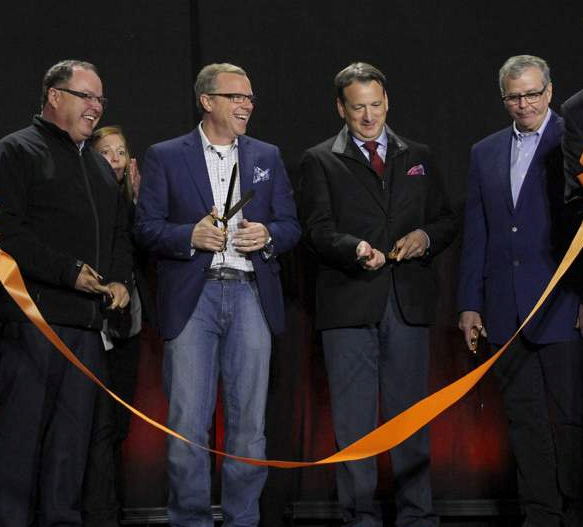SaskPower’s most expensive project ever is now in full functioning flight.
Clean coal is no longer an oxymoron, said Saskatchewan’s Premier Brad Wall Thursday morning as he and other provincial officials cut a ribbon to officially declare the Boundary Dam carbon capture plant, attached to the Unit 3 power unit, open.
In fact, the island that captures 90 per cent of the unit’s noxious carbon dioxide and 100 per cent of the sulphur dioxide had been functioning since Sept. 14 when the full-court press on the test runs were initiated.
On the Wednesday afternoon prior to the Oct. 2 official launch, Cenovus Energy Inc., the recipient of the CO2, picked up the gas right from the plant when it entered their pipeline that is attached directly to the capture plant, sending it to their nearby well sites to be used for enhanced oil recovery systems.
“It was 2,300 hundred tonnes, and we’re being paid for it,” said SaskPower president and CEO, Robert Watson, after stating to an applauding audience of about 250 invited guests, that “It works. It’s working.”
“We started picking the CO2 up at 3 p.m. yesterday,” said Cenovus spokeswoman Jessica Wilkinson who made the trip from the company’s Calgary headquarters to attend the celebration and who spoke with the Mercury following the official launching ceremonies.
“No glitches, the quality is very high.”
The carbon capture capabilities at Saskatchewan’s largest power production plant, now provides SaskPower with another option in which to address greenhouse gas emissions and emerging environmental regulations.
Wall said the province’s quest for balance with regards to doing what’s best for the economy and the environment led them to this particular project and this specific day of celebration.
“We had a choice of low-cost energy versus higher cost but better for the environment decisions … until today,” said Wall, noting that 1,200 new coal fired plants were being planned around the world as he spoke. “That’s why coal is still part of the mix. There is reason for hope as of today. The message is that maybe there is more choice after all.”
Wall said the message has been sent that technological solutions can be found, noting that the new capture system includes zero fly ash emissions, too, as well as nearly eliminating all the CO2 and all the SO2.
“This is the first generation of this technology and it has received a lot of media coverage,” the premier said, thanking the federal government for its $240 million cash injection into the $1.4 billion project at the early stage of development, in 2010.
He said the decision to move forward with the project was not an easy one, but rather one filled with a lot of discussion and tension, but thanks to the professionalism of the SaskPower team, including their board and dedicated unionized employees, they’ve managed to put the words clean coal back into the vernacular as to what SaskPower can provide.
Greg Rickford, Canada’s Minister of Natural Resources, was also on hand, noting that the federal government was on board as early as 2008. It was also noted that Souris-Moose Mountain MP Ed Komarnicki had been championing the project since its inception, said the company’s leader.
“Saskatchewan’s resource economy is becoming a powerhouse, an energy super power and it’s on the leading edge of clean technology,” said Rickford. “Sorry Mr. Obama, we’re leading the way. This project represents a major step forward for clean technology,” he added.
With Saskatchewan now in a position of global leadership in the removal of carbon dioxide in a commercial-sized generating unit, there was speculation as to what the next steps would be.
One million tonnes of CO2 is being removed, the equivalent of taking 250,000 gasoline powered vehicles off the road annually, while still producing 110 to 115 megawatts of electrical power into the provincial grid.
“Saskatchewan’s expertise will be in high demand,” said Rickford. “The world will be looking to Saskatchewan for responsible resource development in the future.”
Watson noted that the project involved over 1,700 contributors, especially the construction crews.
“Coal is not going away,” said Wall, following the viewing of a short video that showed the progress from planning stages to construction completion.
“Not too many people get to celebrate something as big as this every day, so enjoy,” said Watson.




